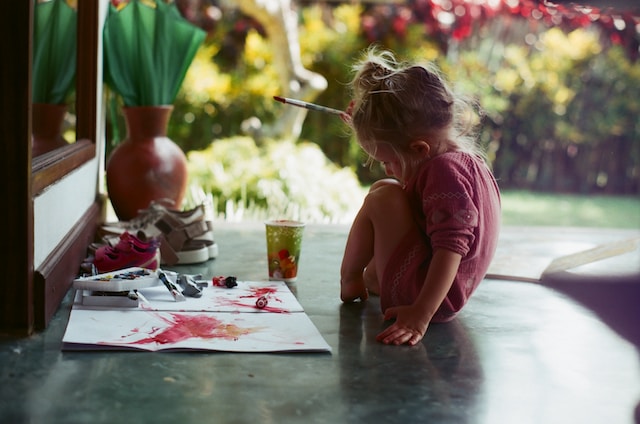Oil painting is a fantastic way for kids to express their creativity and explore the world of art. It’s a great medium to learn, providing endless possibilities for experimentation and exploration.

Source – Unsplash
But getting started with oil painting can be intimidating for parents and children. Here are five tips on getting your kids interested in oil painting so they can begin creating their own masterpieces!
Introduction to Oil Painting for Kids
Oil painting is a fantastic way for kids to explore their creativity and express their inner artist. With a few supplies and some guidance, children can easily learn how to create beautiful works of art with oil paint.
To gauge their interest, you can take them to art exhibits or browse oil paintings for sale online to see if they express any fascination.
The versatility of this medium allows for endless experimentation with color, texture, and form, giving kids the freedom to explore their imaginations and create something truly unique.
Whether they’re painting landscapes, portraits, or abstract designs, oil painting is a fun and rewarding hobby that can provide hours of entertainment and satisfaction for kids of all ages.
Benefits of Learning Oil Painting
Learning oil painting brings many benefits to your children. It helps stimulate their creative thinking, encourages self-expression, and teaches them color theory and composition basics. Moreover, oil painting can help children develop fine motor skills, improve eye-hand coordination and even increase their attention span.
By working with this medium, kids will also learn about art history, develop an appreciation for the work of famous painters and increase their knowledge of art techniques. Now let’s get into how you can set your little one up for success.
1. Get the Right Supplies
Before you start with oil painting, gather all the necessary supplies for your child. Ensure they have an easel or a flat surface to work on, a palette to mix colors, some brushes, and jars for water.
Oil paints come in many varieties. Depending on your budget, you can choose from basic student-grade or artist-quality brands. You may also want to purchase some turpentine or mineral spirits if you plan on using traditional oil painting techniques.
2. Set Up an Art Space
Choose a spot with plenty of natural light and enough room to spread out all the supplies. Make sure the area is well-ventilated, as oil paints give off fumes. Finally, consider adding some decorations like framed artwork or motivational quotes to make the area more inviting and inspiring.
3. Start With a Simple Project
Any form of creative outlet will come with a learning curve. Starting slowly and building up your child’s confidence can make a big difference in their development.
For beginners, opt for a simple project like a still life or landscape that requires only a few colors and techniques. This will help them get used to the textures and properties of oil paint before moving on to more complex subjects.
4. Creating a Comfortable Environment for Painting
Make sure your child is comfortable and relaxed before they start painting. This will help them focus and concentrate on the task at hand.
Play some soothing music, offer encouraging words of support, and provide snacks or drinks if necessary. If you have multiple children, make sure they have enough space to work without feeling cramped or crowded.
5. Introducing Your Child to Different Techniques
Once your child has become comfortable with the basics of oil painting, introduce them to different techniques.
Show them how to create interesting textures and experiment with light and shadow, or demonstrate how to mix colors and use glazes for a more dynamic effect. There are many resources available online that can help teach kids the finer points of oil painting.
Wrapping It Up
Oil painting is a wonderful creative outlet for children of all ages. It encourages self-expression, helps them develop fine motor skills, and teaches them color theory and composition basics.
By introducing your kids to oil painting with the right supplies, setting up an art space in their home, and providing guidance on techniques, you can help foster their creativity while having fun together.
If you found value in today’s post, check out this one on tips for helping your curious kids.
















Add Your Comment